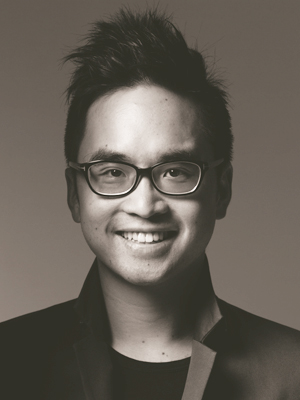Q&A with Adrian Cheng

Adrian is an art pioneer and founder of the K11 Art Foundation (KAF). Growing up in Hong Kong, Adrian also spent a number of years in the United States, and graduated from Harvard University with a BA (Cum Laude). He also received an Honorary Doctorate of Humanities from the Savannah College of Art and Design in 2014. His experiences in Asia and the West equipped him to combine the best of both cultures, and bring a new dimension to the community and beyond.
Adrian is also a board director of the National Museum of China Foundation, trustee of the Royal Academy of Arts, visiting committee at The Metropolitan Museum of Art, member of Tate’s Asia-Pacific Acquisitions Committee, and a member of the International Circle of Centre Pompidou. In early 2013, Adrian spearheaded a new collaboration with Central Saint Martins College of Art and Design in the United Kingdom, setting up an annual full scholarship program for MA candidates, to help students from Hong Kong and mainland China study at CSM.
Q: How and when did you start collecting art? Can you tell us a bit about the changes in the art market that you’ve witnessed over the years as a collector, and how they have affected your collecting?
A: I have always been passionate about art, and interested in culture and creativity. I studied East Asian studies at Harvard, and later spent a year in Kyoto studying the art and culture of Japan. Soon, I found myself buying artworks and building my own collection. I can’t remember exactly when I started, but I would say five or six years ago.
Today, more collectors are interested in Chinese Art than 20 years ago. Just look at the Met’s Ink Art Chinese Contemporary Art exhibition, and The Armory Show’s Chinese Contemporary Art symposium; Chinese artists and their works are getting a lot of attention, especially from the West. In addition, Chinese collectors have become more active in the market. In fact, I have seen many Chinese collectors, including some younger ones, in Basel earlier in June this year.
But, in truth, this has very little effect on my own collection. I only collect works that I feel connect to my own interests.
Q: How do you decide which artworks to add to your collection?
A: I like to meet with artists and talk about their works before actually acquiring a piece. It gives me a better understanding of their background, their story, their concept, and the message they are trying to convey.
Q: Today, Chinese collectors have become a significant force in the international art market. How do you think Chinese collectors are different from Western collectors?
A: Asian collectors who have been collecting for many years are more conservative—they want blue-chip artists. That said, the Contemporary Chinese art market has been more active in the past few years, and many Chinese collectors are now buying Contemporary works, too, Eastern and Western. There is a need for cross-cultural understanding, and it is encouraging to see a new generation of collectors who studied in the West speak the same language as the rest of the art world.
Q: You founded the K11 Art Foundation, and brought curated art exhibitions into the mall. In addition, you have also opened art villages in Guiyang and Wuhan. Can you talk about your transition from a collector to the owner of a foundation who also works within the retail sphere? What motivated your decision?
A: I set up the K11 Art Foundation in 2010 as the first non-profit and non-state-owned art foundation in China with two clear objectives in mind: to support the development of Chinese Contemporary Art worldwide, and to promote international art to the Chinese public. I wanted to support Chinese artists as they developed their technique and their aesthetic, and help them gain exposure, both in China and abroad. At the same time, having grown up admiring many Chinese and Western masterpieces, I was keen to share this passion with the Chinese public, and stimulate their interest and curiosity in all art forms.
Our main activity in China lies in our artist villages in Guiyang and Wuhan, where we have established 17 studios with artist-in-residence programs. The villages serve as a platform to foster and promote promising artists through artist exchanges and museum exhibitions.
I created a new hybrid model, combining art and commerce, and introduced the museum retail concept—K11 built high-end lifestyle art malls, offices, and serviced apartments across Greater China. Exhibitions and art pieces are infused into public spaces within K11 projects in order to bring art to a wide audience. The K11 brand is built around three core values—Art, People, and Nature—with a wider mission to raise cultural and environmental awareness among the general public.
Q: Claude Monet’s works have been displayed in prestigious museums all over the world, but for the first time, his art was brought to your mall in Shanghai earlier this year. How do you think the environment in which an artwork is presented affects the audience’s perception of, or connection with, the work?
A: The exhibition space is part of the Shanghai K11 Art Mall, and we run it just like a museum. In our exhibitions, such as the recent Monet exhibition, we put a lot of emphasis on respecting artworks by presenting them in a space where the audience can fully focus on them, without the distractions that sometimes arise in a retail project.
The difference is, our exhibition space is accessible to people who might not necessarily take the initiative to go to other established museums. In a sense, we are converting our audience into museum-going crowds, and, so far, the trend has proved to be very successful. The Monet exhibition was open for three months, from early March to late June, and over 340,000 visitors bought tickets to see the show. The exhibition was also supplemented by weekend seminars, workshops for children, and artist talks. With the K11 museum retail concept, we are creating an art community.
Q: What is this year’s unmissable art exhibition?
A: I want to say that they are all unmissable! Among them, my first curated show, Space Painting by Zhang Enli, was my personal favorite. This show meant a lot to me; I have been following the artist for many years, seeing his development, and I feel connected with what he is doing. I was glad to continue supporting Zhang Enli in a different way, going from a collector of his works to a curator.
The other big exhibition is definitely our co-curated show with Palais de Tokyo in October, during FIAC this year. In January 2014, KAF and Palais de Tokyo agreed to a three-year collaboration, starting in 2014. The exhibition, due to open during FIAC, and curated by Jo-ey Tang and Wang Chunchen of the Central Academy of Fine Arts Museum in Beijing, will feature five artists from China and three from France: Li Gang, Edwin Lo, Wu Hao, Yu Ji, Zhao Yao, Nadar, Renaud Jerez, and Aude Pariset. The exhibition will later travel to China, where it will be showcased to the greater public after it closes in Paris, in January 2015.
Q: From your perspective, what is the role of a collector in the art world? What kinds of relationships do collectors have with museums, galleries, auction houses, art fairs, etc.?
A: In many cases, including my own, I have found that collectors are often more than just collectors. They are people who are passionate about a certain artistic style, movement, or social issue, and many are active advocates of art who support its development in various ways, from helping to set up shows with art galleries to promoting artists and organizing talks during art events. Of course, there are also some retired collectors who prefer to keep a lower profile, and want to enjoy artworks in a private setting.
On the whole, I think it is important for people to perceive collectors not as mere customers, but rather as integral members of the art community, who have followed and grown together with a multitude of artists and gallerists, and who contribute to the ebb and flow of art movements, not only as collectors, but also as supporters.
Q: If you could have dinner with three artists, living or dead, who would you choose?
A: Paul Cézanne, Jean-Michel Basquiat, and Zhang Enli because they were and are pioneers of their times, and I feel quite attached to this sentiment because I’m part of the new generation, pioneering to build a platform for the development of Chinese Contemporary Art.
Q: What is your advice for novice collectors interested in Chinese Contemporary Art?
A: My advice would be the same for any collector, regardless of what kind of art they are interested in: Do research about artists you like, and, if possible, try to meet with the artists and curators. If you are unsure about a piece of art, having the artist explain his or her vision can really give the piece more personal value. In Chinese Contemporary Art, as in Western art, we have big established names, as well as young emerging artists. Decide for yourself which ones speak the most to your creative side. Collecting for me is not a question of business or valuation, it is a question of personal inclination to certain concepts and aesthetics. If you are in a position to collect, my second advice would be: Collect with your heart, not your balance sheet. •







